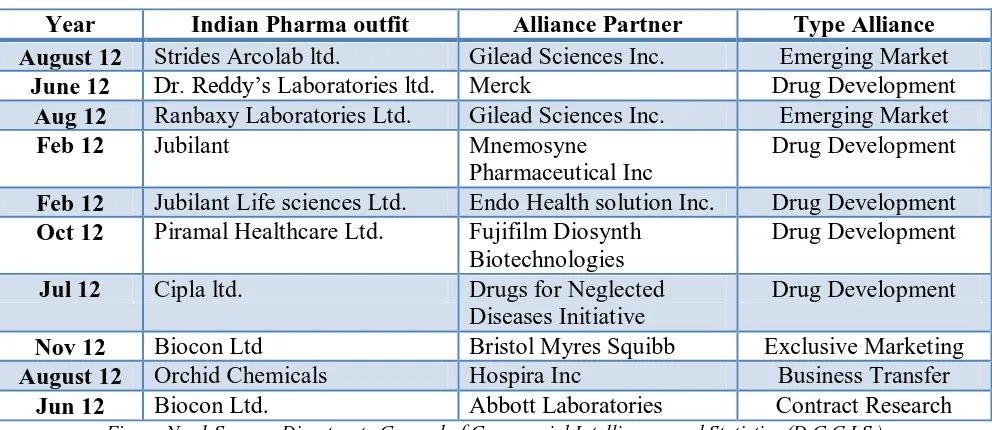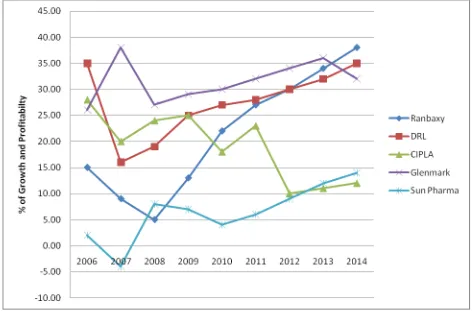Changing Landscape in Marketing Strategies of Indian Pharmaceutical Industry
Dr. Vishnu Prakash Mishra1
Rohit Kumar Vishwakarma2
1. Assistant Professor, United Institute of Management Allahabad, email id:
vishnumishra@hotmail.com
2. Senior Lecturer, United Institute of Management Allahabad, email id:
rohitvish24@gmail.com
SHIV SHAKTI
International Journal in Multidisciplinary and Academic Research (SSIJMAR)
Vol. 2, No. 6, November- December (ISSN 2278 – 5973)
Abstract
India is a monopolistic market, in which lots of industries are participating. After 2005 Patent regime only those companies will survive in Indian market who have got their own Patented Product. In lieu of this act, lots of mergers and acquisitions done by Indian Pharmaceutical MNCs like GLAXO & SMITHKLINE, ZYDUS & CADILA, which also aggravated a tough competition in Indian territories. To overcome from this competition companies have adopted different marketing strategies in Business Environment.
The changing Landscape in marketing strategies is highly in-predictable. Companies have adopted targeted advertising strategy for pharmaceutical OTC products and concept selling strategies are evolved for medicinal and pharmaceutical generic drug segments. The article focuses on various marketing strategy and their outcomes for Indian Pharmaceutical industry. It will also emphasis on changing landscape in marketing strategy with special reference to channel of distribution adopted by Indian pharmaceutical industry. This study also reveals about marketing mix strategy and customer’s (doctors) and end customer’s perception (patients) which is the base of formulation of different marketing strategies. An in-depth analysis has been done to analyze issues and challenges faced by pharmaceutical industry in India.
Strategic Alliances in Indian Pharmaceutical Industry
In global competitive environment companies have got either tough competition or get saturated in
monopolistic market, they try to expand their horizons in various economies, through mergers,
acquisitions, collaborations or amalgamations. Companies are having their own expertise as per the
changing need of business accordingly they joint hands with various pharmaceutical companies. As
per the Indian Foreign Direct Investment policy it allows up to 49% investment in Indian
Pharmaceutical Industry. In lieu of that, if foreign based pharmaceutical companies would like to
enter in India necessarily it should joint hands with Indian Pharmaceutical Companies. Apart from
this as per the WTO Act (previously GATT) only those companies will survive in India or global
market, who have got their own patented product, which also enforce pharma companies for various
strategic alliances.
List of Alliances Entered Into By Indian Pharmaceutical Companies
Year Indian Pharma outfit Alliance Partner Type Alliance August 12 Strides Arcolab ltd. Gilead Sciences Inc. Emerging Market
June 12 Dr. Reddy’s Laboratories ltd. Merck Drug Development Aug 12 Ranbaxy Laboratories Ltd. Gilead Sciences Inc. Emerging Market
Feb 12 Jubilant Mnemosyne
Pharmaceutical Inc
Drug Development
Feb 12 Jubilant Life sciences Ltd. Endo Health solution Inc. Drug Development Oct 12 Piramal Healthcare Ltd. Fujifilm Diosynth
Biotechnologies
Drug Development
Jul 12 Cipla ltd. Drugs for Neglected Diseases Initiative
Drug Development
Nov 12 Biocon Ltd Bristol Myres Squibb Exclusive Marketing August 12 Orchid Chemicals Hospira Inc Business Transfer
Jun 12 Biocon Ltd. Abbott Laboratories Contract Research Figure No. 1 Source: Directorate General of Commercial Intelligence and Statistics (D.G.C.I.S.)
The above table emphasizes on the marketing strategy adopted by various Indian and Overseas
Pharmaceutical Companies to expand its horizon in Indian market through Strategic Alliances.
Companies like Dr. Reddy’s Laboratories ltd. with Merck , Jubilant Life sciences Ltd. with Endo
Strategic Alliance with Bristol Myres Squibb for exclusive marketing, Orchid Chemicals have joint
hands with Hospira Incorporation for business transfer, Biocon has time based collaboration with
Abbott Lab. for contract research. Through these strategic alliances companies are participating in
Indian Market and they are giving their remarkable contributions in the treatment of Chronic
Year Value of Import of ‘Medicinal and Pharmaceutical Products’ (Rs in Crore)
Growth (%)
2002-03 2,865 -
2003-04 2,956 3.18
2004-05 3,139 6.19
2005-06 4,515 43.84
2006-07 5,868 29.92
2007-08 6,734 14.79
2008-09 8,649 28.43
2009-10 9,959 15.15
2010-11 10,937 9.82
Figure No. 3 Source: - Directorate General of Commercial Intelligence and Statistics (D.G.C.I.S.) Kolkata, value of imports of “Medicinal and Pharmaceuticals Products” for the period 2002-03 to 2010-11
Year Value of Export of ‘Medicinal and Pharmaceutical Products’ (Rs in Crore)
Growth (%)
2002-03 12,826 -
2003-04 15,213 18.61
2004-05 17,228 13.25
2005-06 21,230 23.23
2006-07 25,666 20.89
2007-08 29,354 14.37
2008-09 39,821 35.66
2009-10 42,456 6.62
2010-11 47,551 12.00
Figure No. 3 Source: - Directorate General of Commercial Intelligence and Statistics (D.G.C.I.S.) Kolkata, value of imports of “Medicinal and Pharmaceuticals Products” for the period 2002-03 to 2010-11
As per the profitability trend in Indian Pharmaceutical Industry, we can easily visualize an
incremental progress every year in export and import in medicinal and pharmaceuticals segments.
The trend can also be interpreted with the help of given table which shows remarkable incremental
in export due to Indian FDI policy, Patent Rules and Strategic Alliances made by various Indian and
Figure No. 4 Source: - Directorate General of Commercial Intelligence and Statistics (D.G.C.I.S.) Kolkata, value of
imports of “Medicinal and Pharmaceuticals Products” for the period 2002-03 to 2010-11
Profitability Trend in Indian Pharmaceutical Industry
The major players of Indian pharmaceutical industries are Ranbaxy, DRL, CIPLA, Glenmark and
Sun Pharmaceutical who have adopted aggressive marketing strategy to promote medicinal and
pharmaceutical brands in different Indian territories. Ranbaxy is major AIDS drug promoter in South
Africa which tends to incline its profitability during financial year 2008 to 2013 onwards. The graph
also shows an inclining trend for DRL and Glenmark and Sun Pharmaceutical due to increase in
market share of therapeutics segment. Cipla has got tough competition in respiratory division
especially products like Motelucast, Fluticazone, Salmetrol, are not able to survive, due to which
there is rapid decline in its market share during 2010-11. But since it is entering in generic division
there is bit increase in market share during the year 2013.
2,865 2,956 3,139 4,515 5,868
6,734 8,649 9,959 10,937 12,826 15,213 17,228 21,230 25,666 29,354 39,821 42,456 47,551 0 10,000 20,000 30,000 40,000 50,000 60,000 70,000
2002-03 2003-04 2004-05 2005-06 2006-07 2007-08 2008-09 2009-10 2010-11
Figure 5. Source: Brand Manual; Cipla & Ranbaxy 2013
Marketing strategies in Pharmaceutical industries
Far – reaching changes have been taking place in the Indian economy for pharma industry during the
recent past, consequent to the opening up of our economy through globalization and liberalization
policies. The floodgates have been thrown open to allow international competition for manufactures
goods as well as services, making it a question of survival of the fittest in any industry.
In the present highly competitive economy, which can be called a buyer’s market, it is the customer
who wields full power. He can make or wreck a company. No wonder that the collective battle cry
from sales and marketing people, retailers, wholesalers and advertising wizards alike is now ‘Serve
the Customer’ or Delight the Customer’. The customer who was considered the ‘King’ is now
Figure No. 6 Marketing Mix strategy for Indian Pharmaceutical Industry
The four Ps of marketing have to be assembled in the best possible combination. This process
involves choosing the appropriate marketing activities and the allocation of the appropriate
marketing effort and resources to each one of them. The organization has to consider how to
generate targeted sales and profitability. Different combinations of marketing mixes are considered
with varying levels of expenditure on each marketing activity to identify the most effective
combination. It then chooses the best combination of mix of product, price, place and promotion to
ensure success. Target Customers for Pharmacuetical Industry Intended Positioning PRODUCT
1. Vairety of OTC and Pharmaceutical Genric Drugs 2. Quality and efficacy of drugs approved by US FDA and other
quality certification
3. Design of medicines to protect ingredients 4. Features for broad spectrum drugs
5. Brand Name based on R&D, trademark, compositions & Patent 6. Services of sales force for concept selling
Price
1. List Price at different level of intermediaries 2. Discounts for industrial
and consumer buyers 3. Allowances for dealers
& retailers. 4. Payment Periods & Credit Terms depeding on profile of pharma co.
PLace
1. Channels for conumer and industrial market 2. Coverage Assorments for urban & rural interiors 3.Transportation for speedy delivery and proper cold
chain maintanence 4. Logistics Promotion
1. Advertising for OTC Drugs
2. Personal Selling for drug's & devices
3. Sales Promotion for consumer & industrial market
Figure: 7 (Flow of Pharmaceutical Drugs)
Intermediaries are the pillars for pharmaceutical industry as they honor doctor’s prescription. The
distribution starts from company and then its ownership transfer to the Carrying & Forwarding
agents who are basically regional/state agent and then drugs are shifted to stockiest, who are looking
after single territories for making drugs available to different retail outlets for urban and rural
interiors. This is the most important intermediary between doctors (Core Customer) and patients
(end Customer).
Changing Dynamics of Channels in Indian Pharmaceutical Marketing
The Indian drug distribution system has a small layers of C&F agent, stockiest and pharmacist. The
drugs are being promoted to core customers (doctors) and it should be readily available at different
stocks and retail outlet so that his prescription can be honored. The Indian Pharmaceutical industry
has developed three layers for consumer market and zero, one or two level depending on demand for
institutional marketing.
End Customer (Patient)
Non Customer (Retailer)
Customer (Stockiest)
Customer (C & F ) Core Customer
Figure No. 8 Channel of Distribution in Pharmaceutical Industry
CONCLUSION
Indian Pharmaceutical industry is in life saving process which is evolved by various marketing
strategies. In theory as well as in practice marketing strategies can be combined in number of ways.
Optimization is to be achieved by trying out several alternative combinations. The marketing mix
elements are substitutable by one another to a certain extent, in which intermediaries have got prime
importance in making medicines readily available in market. Resources can be taken from one
element and assigned to another, to achieve balance as per the marketing objectives of Industrial
pharmaceutical Industry.
In today’s business environment some unethical marketing is also involved to promote drugs which
are categories as ‘F Class’ drugs from US FDA. Government should take strict action against
Bibliography:
Agarwal P.K, Marketing Management: An Indian perspective, Pragati Prakashan, Merrut 2004
Agarwal, S., Desai, S., Holcomb, M. and Oberoi, A. 2001, ‘Unlocking the value of Big Pharma’,The McKinsey Quarterly, No. 2.pp. 65-73.
AstraZeneca 2001, ‘AstraZeneca Approach to E-Business’, presentation to analysts, New York.
Blumberg, D. and Perrone, F. 2001, How Much are Marketing and Sales Capabilities ReallyWorth? A European Study on How the Capabilities Drive Performance, the European Study.
Brownlee, Shannon. (4 April 2004). Doctors without borders: Why you can’t trust medical journals anymore
Karunakaran K., Marketing Management, Himalaya Publishing House, Mumbai 2010
Kotler Philp, Keller Kevin Lane, Koshy Abrahama, Jha Mithleshwar, Marketing Management; A South Asian perspective, Pearson Education, Singapore 2007
Pharmaceuticals: The Indian Pharmaceutical Industry, Feb 2010, ICRA
Pharmaceutical Research and Manufacturers of America (PHARMA) 2012, Pharmaceutical Industry Profile 2009, Washington.





